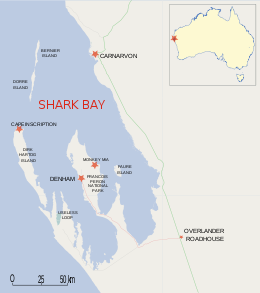|
Bernier Island
Bernier Island is one of three islands that comprise the Bernier and Dorre Island Nature Reserve in the Shark Bay World Heritage area in Western Australia.[1] The island and the neighbouring Dorre Island were locations for a lock hospital in the early 1900s.[2]: 58–61 [3] GeographyIt is located at the north-western corner of the World Heritage area, almost due west of Carnarvon, Western Australia. The 2.6-hectare (6-acre) Koks Island is offshore from the lighthouse at its northern end. It is separated from Dorre Island to its south by a 500-metre (1,640 ft) gap with a depth of 4 metres (13 ft). FaunaThe island is home to one of the few remaining colonies of the Banded Hare-wallaby (Lagostrophus fasciatus)[4] and the endangered species of mouse Pseudomys fieldi, known as djoongari or the Shark Bay mouse, of which there are an estimated 5,000 to 9,000 individuals.[5] Use as a lock hospital (1908-1919)In 1908 the Western Australian government created lock hospitals on Bernier and Dorre Islands, in order to forcibly incarcerate Aboriginal people suspected of having venereal disease.[6]: 59–61 Aboriginal men were mostly detained on Bernier; Aboriginal women and children, mostly on Dorre. The facilities at the lock hospitals were inadequate, inmates had no contact with their families back home, and underwent experimental medical treatments.[7] It is conservatively estimated that 200 people died on the two islands, with their remains left in unmarked areas.[8] During the 2019 centenary commemoration, Regional Development Minister Alannah MacTiernan described the Bernier and Dorre lock hospital era as "a really horrific piece of Western Australian history".[7] MemorialIn April 2019 the Lock Hospital Tragedy Memorial Don't look at the Islands was installed on the mainland at Carnarvon, near the place where Aboriginal detainees were taken by boat to Bernier and Dorre.[8] See alsoReferences
|
||||||||||||||
